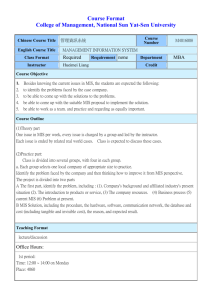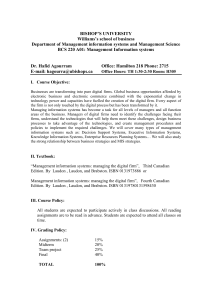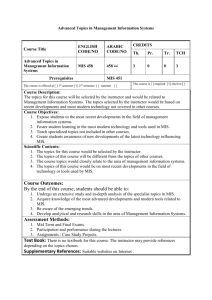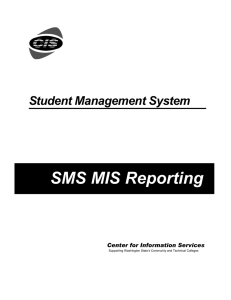Fall 2008-BUS-561
advertisement
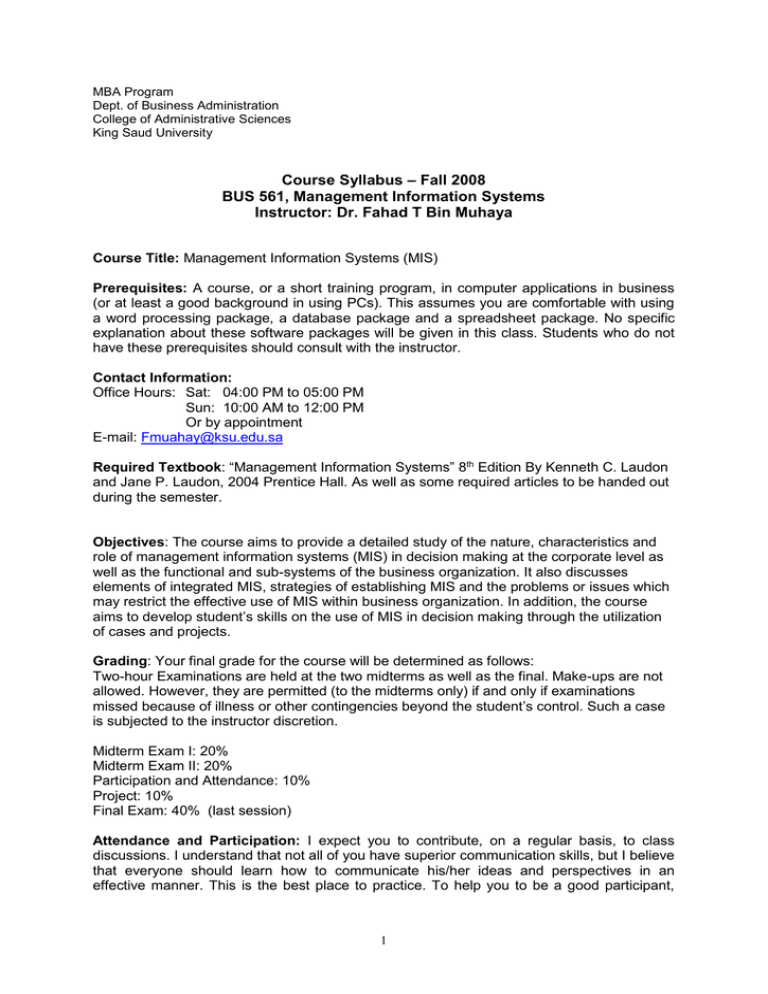
MBA Program Dept. of Business Administration College of Administrative Sciences King Saud University Course Syllabus – Fall 2008 BUS 561, Management Information Systems Instructor: Dr. Fahad T Bin Muhaya Course Title: Management Information Systems (MIS) Prerequisites: A course, or a short training program, in computer applications in business (or at least a good background in using PCs). This assumes you are comfortable with using a word processing package, a database package and a spreadsheet package. No specific explanation about these software packages will be given in this class. Students who do not have these prerequisites should consult with the instructor. Contact Information: Office Hours: Sat: 04:00 PM to 05:00 PM Sun: 10:00 AM to 12:00 PM Or by appointment E-mail: Fmuahay@ksu.edu.sa Required Textbook: “Management Information Systems” 8th Edition By Kenneth C. Laudon and Jane P. Laudon, 2004 Prentice Hall. As well as some required articles to be handed out during the semester. Objectives: The course aims to provide a detailed study of the nature, characteristics and role of management information systems (MIS) in decision making at the corporate level as well as the functional and sub-systems of the business organization. It also discusses elements of integrated MIS, strategies of establishing MIS and the problems or issues which may restrict the effective use of MIS within business organization. In addition, the course aims to develop student’s skills on the use of MIS in decision making through the utilization of cases and projects. Grading: Your final grade for the course will be determined as follows: Two-hour Examinations are held at the two midterms as well as the final. Make-ups are not allowed. However, they are permitted (to the midterms only) if and only if examinations missed because of illness or other contingencies beyond the student’s control. Such a case is subjected to the instructor discretion. Midterm Exam I: 20% Midterm Exam II: 20% Participation and Attendance: 10% Project: 10% Final Exam: 40% (last session) Attendance and Participation: I expect you to contribute, on a regular basis, to class discussions. I understand that not all of you have superior communication skills, but I believe that everyone should learn how to communicate his/her ideas and perspectives in an effective manner. This is the best place to practice. To help you to be a good participant, 1 occasionally, I will post some challenging questions in the class to encourage active involvement. Project Guideline: A detailed guideline sheet for the term project will be handed out on the second meeting General Information: In general, I like to maintain an open door policy, but I require that students be prepared when they come to ask questions. I encourage student to email me when a question or problem surfaces that doesn't need to be immediately addressed. If I feel that the class can benefit from my response, I will keep the source anonymous and respond to the class via e-mail. I would also encourage students to ask questions during the class time so everyone can benefit. Students are responsible for keeping abreast of course materials, special events and project milestones by attending classes and keeping track of all handouts. A TENTATIVE COURSE OUTLINE The course topics outline (below) is tentative and subject to change during the semester. I will announce special events, project milestones and revisions to our agenda via e-mail, but e-mail is not 100% reliable!!! - - - - - ORGANIZATIONS, MANAGEMENT, AND THE NETWORKED ENTERPRISE - Managing the Digital Firm (Chapter.1) - Information Systems in the Enterprise (Chapter 2) - Information Systems, Organizations, Management, and Strategy (Chapter 3) - The Digital Firm: Electronic Commerce and Electronic Business (Chapter.4) - Ethical and Social Issues in the Digital Firm (Chapter.5) INFORMATION TECHNOLOGY INFRASTRUCTURE - Managing Hardware and Software Assets (Chapter.6) - Managing Data Resources (Chapter.7) - Telecommunications and Networks (Chapter 8) - The Internet and the New Information Technology infrastructure: (Chapter 9) MANAGEMENT AND ORGANIZATIONAL SUPPORT SYSTEMS FOR THE DIGITAL FIRM - Managing Knowledge for the Digital Firm (Chapter 10). - Enhancing Management Decision Making (Chapter 11). BUILDING INFORMATION SYSTEMS IN THE DIGITAL FIRM - Redesigning the Organization with Information Systems (Chapter 12) - Understanding the Business Value of Systems and Managing Change (Chapter 13) MANAGING INFORMATION SYSTEMS IN THE DIGITAL FIRM - Information Systems Security and Control (Chapter.14) - Managing International Information Systems (Chapter.15). 2


